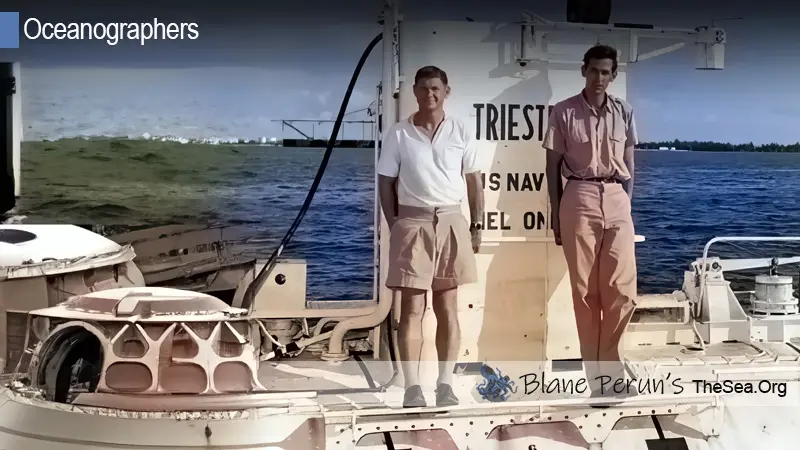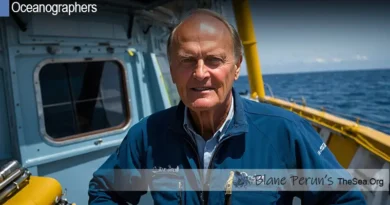Jacques Piccard
Jacques Piccard was born in 1922 in Brussels, Belgium. His father, Auguste Piccard, beat the world record twice for getting to the highest altitudes flying in a balloon, and he decided to use the same type of technology, the buoyancy technique, to develop a vehicle that could submerse, called a bathyscaphe.
Even though he started working as an economics teacher at the University, Jacques Piccard continued to assist his father in improving the bathyscaphe and demonstrating his great potential in the deep waters. They built together three such machines between 1948 and 1955 and managed to reach a depth of 4.600 feet at one point and 10.000 feet at another point, both being record depths.
After this success, Jacques decides to quit economics and further collaborate with Auguste, his father. He contacts the U.S. Navy in order to get financial support in improving his current bathyscaphe – Trieste -even further. The Navy is impressed and decides to buy the vessel and also hire Piccard as a consultant. He gets to reach 24.000 feet with Trieste, but dreams big and acts even bigger. In January 1960, Piccard and his team reaches the floor of the Marian Trench located in the North Pacific Ocean, at a depth close to 39.000 feet, which took almost five hours. They stayed 20 minutes at the bottom and Jacques Piccard decided to cut the journey short as he started seeing cracks on the windows they had. Going back up took three hours and 15 minutes. His next important mission was the one using the Ben Franklin vessel, a mesoscaphe; he descended near the Florida coast, with a crew of six men. Piccard was the leader. Ben Franklin was launched two days before the famous Apollo 11 mission, in 1969. The first mesoscaphe was built by Piccard and his father and was the first vehicle that managed to take passengers underwater.
In 1971, he writes a book about his voyage, which he calls The Sun Beneath The Sea. Afterwards, he becomes a consultant for America, for deep sea researches. He manages to contribute deeply to our knowledge and understanding of the oceans and the depth of the sea and was a huge protector of the life underwater. Jacques Piccard dies in 2008 in Switzerland and gets an award in 2012 for his Mariana Trench expedition, award called the Hubbard Medal.
Jacques Piccard: The Oceanic Explorer Who Defied Depths
When discussing pioneering personalities that have navigated through the intricacies of our planet’s vast and mysterious oceans, Jacques Piccard inevitably takes a spot in the limelight. His tales of relentless exploration are an emblem of humankind’s undying quest to unravel the mysteries that lie beneath the waves. Here, we endeavor to provide an illuminating deep dive into the remarkable life and achievements of Jacques Piccard.
Early Life and Background
Born on July 28, 1922, in Brussels, Belgium, Jacques Piccard belonged to a lineage of explorers and inventors. His father, Auguste Piccard, was an eminent physicist and balloonist, often recognized for his stratospheric balloon flights. Growing up in such an atmosphere, it was no surprise that Jacques developed a passion for exploration.
The Bathyscaphe: A Revolution in Deep Sea Exploration
In collaboration with his father, Jacques took on an ambitious project in the 1950s, aiming to push the boundaries of deep-sea exploration. Together, they conceptualized and built the Bathyscaphe—a submersible vessel specifically designed for deep-sea dives.
Design and Mechanism
The Bathyscaphe was a breakthrough in marine technology. Unlike traditional submarines, which used ballasts to sink and ascend, the Bathyscaphe employed a unique system. It utilized gasoline for buoyancy due to its low density compared to water and iron pellets as ballast.
Breaking Records: The Dive to Challenger Deep
In 1960, Jacques, alongside Lieutenant Don Walsh of the US Navy, embarked on a groundbreaking journey to the Mariana Trench in the Bathyscaphe Trieste. Their mission was to reach the Challenger Deep—the deepest known point in Earth’s oceans. Accomplishing this feat, they descended to a staggering depth of 10,916 meters, setting an unprecedented record.
Pioneering Environmental Awareness
Piccard’s underwater adventures did more than just break records. They brought to the forefront the fragile beauty of our planet’s underwater ecosystems. Jacques became a vocal advocate for ocean conservation, emphasizing the importance of preserving marine biodiversity for future generations.
The Mesoscaphe: A Vision for Public Exploration
To further popularize underwater exploration and marine conservation, Jacques conceptualized the Mesoscaphe, a submersible that could carry multiple passengers. It was an endeavor to make the wonders of the deep accessible to the public. The Mesoscaphe became a staple attraction during the Swiss National Exhibition in Lausanne in 1964.
Legacy and Impact
The indomitable spirit of Jacques Piccard continues to inspire marine biologists, environmentalists, and explorers worldwide. His groundbreaking ventures underscored the limitless possibilities that lie beneath our planet’s waters, waiting to be discovered.
Furthermore, Piccard’s commitment to marine conservation set a precedent for contemporary oceanographic research, emphasizing the importance of sustainable exploration and the stewardship of our natural resources.
Conclusion
Jacques Piccard’s journey from a curious young man to a world-renowned oceanic explorer serves as a testament to the power of determination and vision. In the annals of marine exploration, his name shines bright, guiding future generations towards meaningful discoveries and a greater appreciation of our planet’s aquatic treasures.




